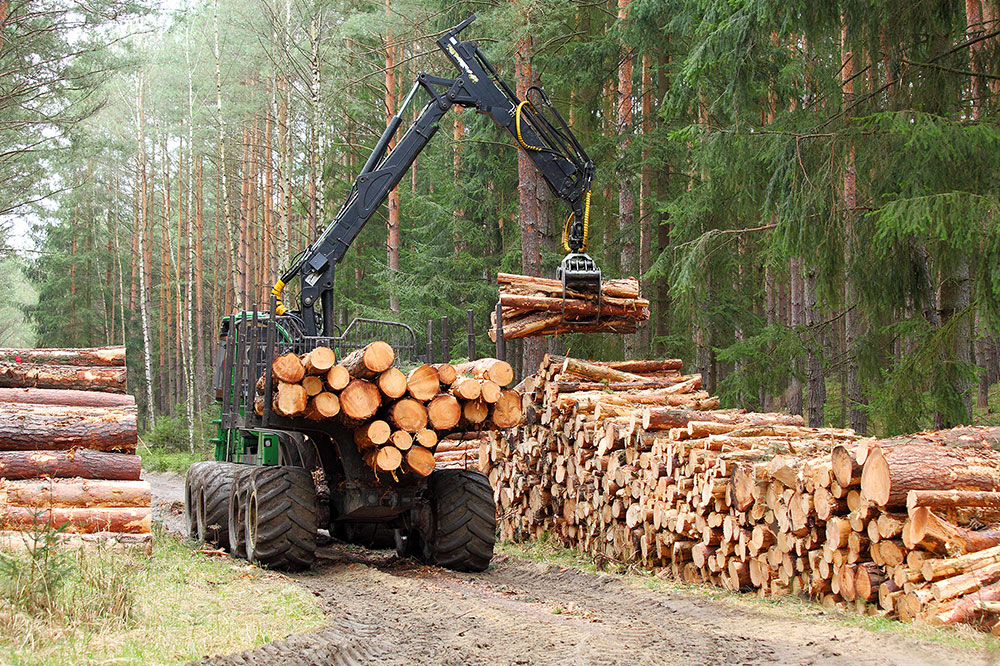
Common tools and equipment used in forestry and logging
Forestry and logging is one of the most profitable industries in areas of dense, natural forest cover. The process involves cutting down timber, transporting it, and selling it to manufacturing units that turn a simple log into furniture or construction material. But manually chopping trees and clearing hundreds of acres of land is time-consuming. Thus, the following types of forestry and logging equipment and tools come in handy to simplify and quicken the process.
Forestry cranes
A forestry logging company will rely on two primary types of cranes to move around to chop down the trees and process the raw timber. The first type is a harvester crane with a dedicated knuckle boom grapple saw built at the end of the crane arm. This tool helps strip and shave off the excess wood covering the log, right from branches and leaves to the bark of the wood. Further, the saw attachment helps cut precise logs, moving the entire tree forward in the same action. The dual purpose saves time by combining tasks and eliminates the need for manual felling. The second type of crane is called a forwarder crane, which comes with a dedicated grappling arm. This crane is directly outfitted to a log transport trailer to pick up and rearrange the logs onto the loader. Many of these functions are automated to save time and effort with some of the newer models.
Feller bunchers
Feller bunchers are very useful forestry and logging equipment that further simplify the process of cutting, shearing, and piling up heavy logs. Much like a harvester crane, these motorized vehicles come in two configurations, wheeled and tracked. Wheeled feller bunchers are more maneuverable on uniform terrain, whereas tracked bunchers are more suitable for uneven terrain. But both have the same function of gripping a tree, sawing it, shearing the excess, and precisely cutting up logs ready for loading the trailer. All this can be done using a single buncher where immediately after cutting, the logs can be directly loaded onto the trailers for transportation.
Knuckle boom loaders
A special hydraulic crane called a knuckle boom loader is used for oversized and large trees. The long arm of the crane provides extended range and flexibility, while the powerful hydraulic boom can grip single or multiple logs to be loaded onto the trailer. Maneuverability is one of the main advantages of using a knuckle boom, as the logs can be rotated in any direction, be it vertically or horizontally. Smaller trees can also be moved in large batches to save time instead of felling and shifting one at a time using just the harvester. A skilled operator takes only a few minutes to completely load up a truck full of processed logs ready for dispatch.
Mulching and land clearing
Mulching and land clearing is a crucial task done to preserve the topsoil and make it suitable for vegetation. It combines all the leaves and organic compost into the soil to prevent moisture from escaping and provide a desirable landscape. Without this process, the area would become barren, rendering it hostile for trees that can grow in place of the ones that have been cut down. Heavy-duty mulching and land-clearing equipment take no more than a couple of hours to get the entire job done. In addition, there are multiple accessories and attachments that further protect the expensive forestry logging tools and equipment from damage during the mulching process.
Semi-trailers
Trailers do all the heavy hauling once the logs are chopped down and collected for distribution. Four main types of semi-trailers are used to transport different sizes of logs, including chipper trailers, lowboy trailers, tag trailers, and log trailers. Chipper trailers can carry maximum loads of wood chips, whereas lowboy trailers are useful for transporting forestry tools and equipment from one location logging site to the other. Tag trailers are standard-use to carry bulk loads of large-size logs, and log trailers are specifically modified to carry oddly shaped wood secured to the processing and distribution center.
Multiple attachments are designed to reconfigure these common tools and vehicles used by forestry and logging services. Depending on the task and scale of operations, companies either buy or lease out heavy-duty machinery to manage large-scale harvesting and processing ventures. Knowing the types of machinery and processes also make it easier for qualified technicians and operators to source specific forestry logging jobs.




